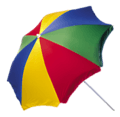Umbrella facts for kids
An umbrella is a handy tool that helps keep you dry when it rains. It's also used to create shade and protect people from the sun. An umbrella made especially for sun protection is called a parasol. Some plastic umbrellas are cheap, but they can break easily.
Contents
What is an Umbrella?
An umbrella is a device that opens up to form a dome-like shape. This shape helps to block rain or sunlight from reaching you. Most umbrellas have a handle, a central pole, and ribs that support the fabric canopy. When you're done using it, you can fold it down to a smaller size, making it easy to carry.
How Umbrellas Work
Umbrellas work by using a frame of metal or plastic ribs. These ribs spread out to hold a waterproof fabric or plastic material. When you push a button or slide a mechanism, the ribs extend, opening the canopy. This creates a barrier against rain or sun. When you want to close it, you push or pull the mechanism again, and the ribs fold back in.
History of Umbrellas
Umbrellas have been around for a very long time! They were first used thousands of years ago, not just for rain, but often as a sign of importance or royalty. Ancient civilizations like the Egyptians, Assyrians, and Chinese used parasols to protect themselves from the sun.
In ancient China, umbrellas were sometimes made of silk and had fancy decorations. They were also used in ceremonies. Over time, umbrellas became more common in other parts of the world, including Europe. At first, they were mostly used by women, but eventually, men started using them too.
Different Types of Umbrellas
There are many kinds of umbrellas designed for different uses:
- Rain Umbrellas: These are the most common type. They are made to keep you dry in the rain. They often have strong, waterproof fabric.
- Parasols: These are specifically for sun protection. They might be made of lighter fabric and sometimes have pretty designs. You often see them on beaches or patios.
- Compact Umbrellas: These are small and foldable, perfect for carrying in a bag or backpack. They are great for unexpected rain showers.
- Golf Umbrellas: These are very large umbrellas designed to cover a person and their golf clubs. They offer more protection from rain and sun.
- Storm Umbrellas: Some modern umbrellas are designed to be extra strong and resist high winds. They might have special vents or shapes to prevent them from turning inside out.
Materials Used
Umbrellas are made from several different materials:
- Canopy: The part that keeps you dry or shaded is usually made from waterproof fabrics like nylon, polyester, or sometimes plastic.
- Frame: The ribs and pole are often made of metal, like steel or aluminum. Some modern umbrellas use fiberglass for a lighter and more flexible frame.
- Handle: Handles can be made from plastic, wood, or rubber. They are shaped to be comfortable to hold.
Umbrellas are a simple but very useful invention that helps people stay comfortable in different weather conditions.
Images for kids
-
Relief of the Persian king Xerxes I (485-465 BC) at Persepolis.
-
A Terracotta Army carriage with an umbrella securely fixed to the side, from Qin Shi Huang's tomb, c. 210 BC.
-
Marchesa Elena Grimaldi, by Anthony van Dyck, 1623.
-
A parasol depicted in Morning Walk, by John Singer Sargent (1888).
-
Collapsed umbrellas in a temple in Japan.
-
Testing a Senz storm umbrella in Rotterdam, using a high-powered fan.
-
Grand Procession of the Doge of Venice (16th century).
-
Ethiopian Orthodox clergymen lead a procession in celebration of Saint Michael. The priests carry ornately covered Tabota around the church's exterior, assisted by deacons holding liturgical umbrellas.
-
A painting of Chancellor Pierre Séguier with a parasol hoisted above his head, by Charles Le Brun, 1670.
-
Japanese girl jumps from Kiyomizu-dera, Suzuki Harunobu, 1750.
-
Pierre-Auguste Renoir, Umbrellas, 1883.
-
Woman with a parasol, by Édouard Manet, 1881.
See also
 In Spanish: Paraguas para niños
In Spanish: Paraguas para niños




























